Papers by Alexander S Ecker
Nature Neuroscience, 2014
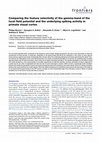
The local fi eld potential (LFP), comprised of low-frequency extra-cellular voltage fl uctuations... more The local fi eld potential (LFP), comprised of low-frequency extra-cellular voltage fl uctuations, has been used extensively to study the mechanisms of brain function. In particular, oscillations in the gamma-band (30-90 Hz) are ubiquitous in the cortex of many species during various cognitive processes. Surprisingly little is known about the underlying biophysical processes generating this signal. Here, we examine the relationship of the local fi eld potential to the activity of localized populations of neurons by simultaneously recording spiking activity and LFP from the primary visual cortex (V1) of awake, behaving macaques. The spatial organization of orientation tuning and ocular dominance in this area provides an excellent opportunity to study this question, because orientation tuning is organized at a scale around one order of magnitude fi ner than the size of ocular dominance columns. While we fi nd a surprisingly weak correlation between the preferred orientation of multi-unit activity and gamma-band LFP recorded on the same tetrode, there is a strong correlation between the ocular preferences of both signals. Given the spatial arrangement of orientation tuning and ocular dominance, this leads us to conclude that the gamma-band of the LFP seems to sample an area considerably larger than orientation columns. Rather, its spatial resolution lies at the scale of ocular dominance columns.

Journal of Neuroscience, 2016
Attention is commonly thought to improve behavioral performance by increasing response gain and s... more Attention is commonly thought to improve behavioral performance by increasing response gain and suppressing shared variability in neuronal populations. However, both the focus and the strength of attention are likely to vary from one experimental trial to the next, thereby inducing response variability unknown to the experimenter. Here we study analytically how fluctuations in attentional state affect the structure of population responses in a simple model of spatial and feature attention. In our model, attention acts on the neural response exclusively by modulating each neuron's gain. Neurons are conditionally independent given the stimulus and the attentional gain, and correlated activity arises only from trial-to-trial fluctuations of the attentional state, which are unknown to the experimenter. We find that this simple model can readily explain many aspects of neural response modulation under attention, such as increased response gain, reduced individual and shared variability, increased correlations with firing rates, limited range correlations, and differential correlations. We therefore suggest that attention may act primarily by increasing response gain of individual neurons without affecting their correlation structure. The experimentally observed reduction in correlations may instead result from reduced variability of the attentional gain when a stimulus is attended. Moreover, we show that attentional gain fluctuations, even if unknown to a downstream readout, do not impair the readout accuracy despite inducing limited-range correlations, whereas fluctuations of the attended feature can in principle limit behavioral performance. Covert attention is one of the most widely studied examples of top-down modulation of neural activity in the visual system. Recent studies argue that attention improves behavioral performance by shaping of the noise distribution to suppress shared variability rather than by increasing response gain. Our work shows, however, that latent, trial-to-trial fluctuations of the focus and strength of attention lead to shared variability that is highly consistent with known experimental observations. Interestingly, fluctuations in the strength of attention do not affect coding performance. As a consequence, the experimentally observed changes in response variability may not be a mechanism of attention, but rather a side effect of attentional allocation strategies in different behavioral contexts.

The relative merits of different population coding schemes have mostly been analyzed in the frame... more The relative merits of different population coding schemes have mostly been analyzed in the framework of stimulus reconstruction using Fisher Information. Here, we consider the case of stimulus discrimination in a two alternative forced choice paradigm and compute neurometric functions in terms of the minimal discrimination error and the Jensen-Shannon information to study neural population codes. We first explore the relationship between minimum discrimination error, Jensen-Shannon Information and Fisher Information and show that the discrimination framework is more informative about the coding accuracy than Fisher Information as it defines an error for any pair of possible stimuli. In particular, it includes Fisher Information as a special case. Second, we use the framework to study population codes of angular variables. Specifically, we assess the impact of different noise correlations structures on coding accuracy in long versus short decoding time windows. That is, for long time window we use the common Gaussian noise approximation. To address the case of short time windows we analyze the Ising model with identical noise correlation structure. In this way, we provide a new rigorous framework for assessing the functional consequences of noise correlation structures for the representational accuracy of neural population codes that is in particular applicable to short-time population coding.

Science (New York, N.Y.), Jan 27, 2015
Since the work of Ramón y Cajal in the late 19th and early 20th centuries, neuroscientists have s... more Since the work of Ramón y Cajal in the late 19th and early 20th centuries, neuroscientists have speculated that a complete understanding of neuronal cell types and their connections is key to explaining complex brain functions. However, a complete census of the constituent cell types and their wiring diagram in mature neocortex remains elusive. By combining octuple whole-cell recordings with an optimized avidin-biotin-peroxidase staining technique, we carried out a morphological and electrophysiological census of neuronal types in layers 1, 2/3, and 5 of mature neocortex and mapped the connectivity between more than 11,000 pairs of identified neurons. We categorized 15 types of interneurons, and each exhibited a characteristic pattern of connectivity with other interneuron types and pyramidal cells. The essential connectivity structure of the neocortical microcircuit could be captured by only a few connectivity motifs.

Physical review. E, Statistical, nonlinear, and soft matter physics, 2015
Synaptic unreliability is one of the major sources of biophysical noise in the brain. In the cont... more Synaptic unreliability is one of the major sources of biophysical noise in the brain. In the context of neural information processing, it is a central question how neural systems can afford this unreliability. Here we examine how synaptic noise affects signal transmission in cortical circuits, where excitation and inhibition are thought to be tightly balanced. Surprisingly, we find that in this balanced state synaptic response variability actually facilitates information transmission, rather than impairing it. In particular, the transmission of fast-varying signals benefits from synaptic noise, as it instantaneously increases the amount of information shared between presynaptic signal and postsynaptic current. Furthermore we show that the beneficial effect of noise is based on a very general mechanism which contrary to stochastic resonance does not reach an optimum at a finite noise level.
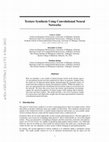
It is a long standing question how biological systems transform visual inputs to robustly infer h... more It is a long standing question how biological systems transform visual inputs to robustly infer high-level visual information. Research in the last decades has established that much of the underlying computations take place in a hierarchical fashion along the ventral visual pathway. However, the exact processing stages along this hierarchy are difficult to characterise. Here we present a method to generate stimuli that will allow a principled description of the processing stages along the ventral stream. We introduce a new parametric texture model based on the powerful feature spaces of convolutional neural networks optimised for object recognition. We show that constraining a spatial summary statistic over feature maps suffices to synthesise high-quality natural textures. Moreover we establish that our texture representations continuously disentangle high-level visual information and demonstrate that the hierarchical parameterisation of the texture model naturally enables us to gen...

Physical Review E, 2015
Synaptic unreliability is one of the major sources of biophysical noise in the brain. In the cont... more Synaptic unreliability is one of the major sources of biophysical noise in the brain. In the context of neural information processing, it is a central question how neural systems can afford this unreliability. Here we examine how synaptic noise affects signal transmission in cortical circuits, where excitation and inhibition are thought to be tightly balanced. Surprisingly, we find that in this balanced state synaptic response variability actually facilitates information transmission, rather than impairing it. In particular, the transmission of fast-varying signals benefits from synaptic noise, as it instantaneously increases the amount of information shared between presynaptic signal and postsynaptic current. Furthermore we show that the beneficial effect of noise is based on a very general mechanism which contrary to stochastic resonance does not reach an optimum at a finite noise level.
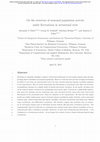
Attention is commonly thought to improve behavioral performance by increasing response gain and s... more Attention is commonly thought to improve behavioral performance by increasing response gain and sup-2 pressing shared variability in neuronal populations. However, both the focus and the strength of attention 3 are likely to vary from one experimental trial to the next, thereby inducing response variability unknown 4 to the experimenter. Here we study analytically how fluctuations in attentional state affect the structure 5 of population responses in a simple model of spatial and feature attention. In our model, attention acts 6 on the neural response exclusively by modulating each neuron's gain. Neurons are conditionally indepen-7 dent given the stimulus and the attentional gain, and correlated activity arises only from trial-to-trial 8 fluctuations of the attentional state, which are unknown to the experimenter. We find that this simple 9 model can readily explain many aspects of neural response modulation under attention, such as increased 10 response gain, reduced individual and shared variability, increased correlations with firing rates, limited 11 range correlations, and differential correlations. We therefore suggest that attention may act primar-12 ily by increasing response gain of individual neurons without affecting their correlation structure. The 13 experimentally observed reduction in correlations may instead result from reduced variability of the at-14 tentional gain when a stimulus is attended. Moreover, we show that attentional gain fluctuations -even 15 if unknown to a downstream readout -do not impair the readout accuracy despite inducing limited-range 16 correlations.
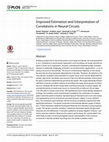
PLoS computational biology, 2015
Ambitious projects aim to record the activity of ever larger and denser neuronal populations in v... more Ambitious projects aim to record the activity of ever larger and denser neuronal populations in vivo. Correlations in neural activity measured in such recordings can reveal important aspects of neural circuit organization. However, estimating and interpreting large correlation matrices is statistically challenging. Estimation can be improved by regularization, i.e. by imposing a structure on the estimate. The amount of improvement depends on how closely the assumed structure represents dependencies in the data. Therefore, the selection of the most efficient correlation matrix estimator for a given neural circuit must be determined empirically. Importantly, the identity and structure of the most efficient estimator informs about the types of dominant dependencies governing the system. We sought statistically efficient estimators of neural correlation matrices in recordings from large, dense groups of cortical neurons. Using fast 3D random-access laser scanning microscopy of calcium s...
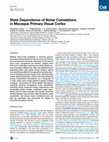
Neuron, Jan 2, 2014
Shared, trial-to-trial variability in neuronal populations has a strong impact on the accuracy of... more Shared, trial-to-trial variability in neuronal populations has a strong impact on the accuracy of information processing in the brain. Estimates of the level of such noise correlations are diverse, ranging from 0.01 to 0.4, with little consensus on which factors account for these differences. Here we addressed one important factor that varied across studies, asking how anesthesia affects the population activity structure in macaque primary visual cortex. We found that under opioid anesthesia, activity was dominated by strong coordinated fluctuations on a timescale of 1-2 Hz, which were mostly absent in awake, fixating monkeys. Accounting for these global fluctuations markedly reduced correlations under anesthesia, matching those observed during wakefulness and reconciling earlier studies conducted under anesthesia and in awake animals. Our results show that internal signals, such as brain state transitions under anesthesia, can induce noise correlations but can also be estimated and...
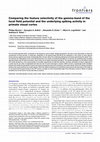
The local fi eld potential (LFP), comprised of low-frequency extra-cellular voltage fl uctuations... more The local fi eld potential (LFP), comprised of low-frequency extra-cellular voltage fl uctuations, has been used extensively to study the mechanisms of brain function. In particular, oscillations in the gamma-band (30-90 Hz) are ubiquitous in the cortex of many species during various cognitive processes. Surprisingly little is known about the underlying biophysical processes generating this signal. Here, we examine the relationship of the local fi eld potential to the activity of localized populations of neurons by simultaneously recording spiking activity and LFP from the primary visual cortex (V1) of awake, behaving macaques. The spatial organization of orientation tuning and ocular dominance in this area provides an excellent opportunity to study this question, because orientation tuning is organized at a scale around one order of magnitude fi ner than the size of ocular dominance columns. While we fi nd a surprisingly weak correlation between the preferred orientation of multi-unit activity and gamma-band LFP recorded on the same tetrode, there is a strong correlation between the ocular preferences of both signals. Given the spatial arrangement of orientation tuning and ocular dominance, this leads us to conclude that the gamma-band of the LFP seems to sample an area considerably larger than orientation columns. Rather, its spatial resolution lies at the scale of ocular dominance columns.
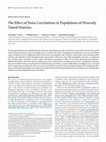
Journal of Neuroscience, 2011
The amount of information encoded by networks of neurons critically depends on the correlation st... more The amount of information encoded by networks of neurons critically depends on the correlation structure of their activity. Neurons with similar stimulus preferences tend to have higher noise correlations than others. In homogeneous populations of neurons, this limited range correlation structure is highly detrimental to the accuracy of a population code. Therefore, reduced spike count correlations under attention, after adaptation, or after learning have been interpreted as evidence for a more efficient population code. Here, we analyze the role of limited range correlations in more realistic, heterogeneous population models. We use Fisher information and maximumlikelihood decoding to show that reduced correlations do not necessarily improve encoding accuracy. In fact, in populations with more than a few hundred neurons, increasing the level of limited range correlations can substantially improve encoding accuracy. We found that this improvement results from a decrease in noise entropy that is associated with increasing correlations if the marginal distributions are unchanged. Surprisingly, for constant noise entropy and in the limit of large populations, the encoding accuracy is independent of both structure and magnitude of noise correlations.
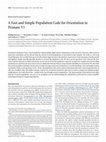
Journal of Neuroscience, 2012
Orientation tuning has been a classic model for understanding single-neuron computation in the ne... more Orientation tuning has been a classic model for understanding single-neuron computation in the neocortex. However, little is known about how orientation can be read out from the activity of neural populations, in particular in alert animals. Our study is a first step toward that goal. We recorded from up to 20 well isolated single neurons in the primary visual cortex of alert macaques simultaneously and applied a simple, neurally plausible decoder to read out the population code. We focus on two questions: First, what are the time course and the timescale at which orientation can be read out from the population response? Second, how complex does the decoding mechanism in a downstream neuron have to be to reliably discriminate between visual stimuli with different orientations? We show that the neural ensembles in primary visual cortex of awake macaques represent orientation in a way that facilitates a fast and simple readout mechanism: With an average latency of 30 -80 ms, the population code can be read out instantaneously with a short integration time of only tens of milliseconds, and neither stimulus contrast nor correlations need to be taken into account to compute the optimal synaptic weight pattern. Our study shows that-similar to the case of single-neuron computation-the representation of orientation in the spike patterns of neural populations can serve as an exemplary case for understanding the computations performed by neural ensembles underlying visual processing during behavior.
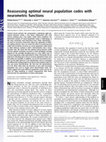
Proceedings of the National Academy of Sciences, 2011
Cortical circuits perform the computations underlying rapid perceptual decisions within a few doz... more Cortical circuits perform the computations underlying rapid perceptual decisions within a few dozen milliseconds with each neuron emitting only a few spikes. Under these conditions, the theoretical analysis of neural population codes is challenging, as the most commonly used theoretical tool-Fisher informationcan lead to erroneous conclusions about the optimality of different coding schemes. Here we revisit the effect of tuning function width and correlation structure on neural population codes based on ideal observer analysis in both a discrimination and a reconstruction task. We show that the optimal tuning function width and the optimal correlation structure in both paradigms strongly depend on the available decoding time in a very similar way. In contrast, population codes optimized for Fisher information do not depend on decoding time and are severely suboptimal when only few spikes are available. In addition, we use the neurometric functions of the ideal observer in the classification task to investigate the differential coding properties of these Fisher-optimal codes for fine and coarse discrimination. We find that the discrimination error for these codes does not decrease to zero with increasing population size, even in simple coarse discrimination tasks. Our results suggest that quite different population codes may be optimal for rapid decoding in cortical computations than those inferred from the optimization of Fisher information.

Neural Computation, 2009
Spike trains recorded from populations of neurons can exhibit substantial pairwise correlations b... more Spike trains recorded from populations of neurons can exhibit substantial pairwise correlations between neurons and rich temporal structure. Thus, for the realistic simulation and analysis of neural systems, it is essential to have efficient methods for generating artificial spike trains with specified correlation structure. Here we show how correlated binary spike trains can be simulated by means of a latent multivariate gaussian model. Sampling from the model is computationally very efficient and, in particular, feasible even for large populations of neurons. The entropy of the model is close to the theoretical maximum for a wide range of parameters. In addition, this framework naturally extends to correlations over time and offers an elegant way to model correlated neural spike counts with arbitrary marginal distributions. * Jakob Macke and Philipp Berens contributed equally to this work.
Nature Neuroscience, 2014
Uploads
Papers by Alexander S Ecker